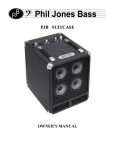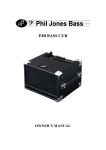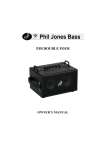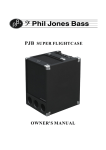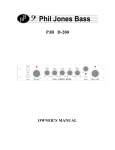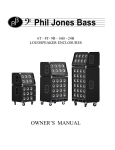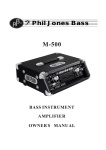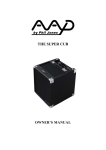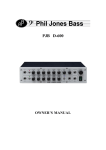Download Master BG 100 Owner`s manual
Transcript
Phil Jones Bass PJB BASS CUB BG-100 OWNER'S MANUAL Thank you for purchasing the PJB BASS CUB. A great deal of dedication and passion went into designing and building this no compromise, high performance compact-combo amplifier. It was conceived to be a dedicated amplifier for the “connoisseur” guitarist. Reading this manual will enable you to get the best performance from it so that you may enjoy many years of service. READ THIS FIRST ! ! ! ! ! ! ! ! ! ! ! ! ! ! Before using the BASS CUB please read ALL the instructions. On receipt of product, check for any signs of physical damage arising from shipping. If any damage is visible contact your dealer. Keep all original packing. Do not use this amplifier in a way that would compromise its ventilation system. When operating, never cover the heat sink on rear panel. Do not locate this amplifier near any heat source. This amplifier must be connected only to a power source specified in this manual. For safety do not leave the amplifier plugged into a power source for long periods of time when not in use. Do not let any liquid or foreign objects fall into any openings on the amplifier. Never use this amplifier if it has: 1. Suffered any physical damage. 2. Been subjected to any liquids, rain or moisture. 3. Damaged cables connected to it. If any of the above occurs, the amplifier should be examined by qualified service personnel. Always operate this amplifier with the correctly rated fuse. Never use this amplifier without proper grounding. The mains plug is used as disconnect device, the disconnect device shall remain readily operable. Protective earthling terminal. The apparatus should be connected to a mains socket outlet with a protective earthing connection. Correct Disposal of this product. This marking indicates that this product should not be disposed with other household wastes throughout the EU. To prevent possible harm to the environment or human health from uncontrolled -1- waste disposal, recycle it responsibly to promote the sustainable reuse of material resources. ! The apparatus shall not be exposed to dripping or splashing. OVERVIEW OF THE BASS CUB Sometimes all you need is an amp that can deliver true bass tones but without the hassle of getting out a big rig amplifier. The Bass Cub is 100 watts of pure tone in a shoebox size package and so light, it can be lifted even with a finger! It can sit on the floor or on top of a desk. Two independent channels can accept two instruments or one microphone. It also has a stereo input for Drum machine or I-pod/MP3 player. Practicing can be done with the 2 internal speakers or headphones. The BASS CUB comes with a padded carrying bag. With these features and great sound there is no longer an excuse you can not practice. AMPLIFIER FEATURES ! ! ! ! ! ! ! ! ! Dual channel switch able high impedance/high gain input OR low impedance/low gain stage with mute function. One stereo input for Drum machine or I-pod/MP3 player. 3 Band EQ. Balanced Line Output with ground lift. Tuner Out. Line Out. Sophisticated protection circuitry. 100watt RMS Amplifier. Ultra low noise pre amplifier circuit. -2- FRONT PANEL OVERVIEW 2 3 1 4 5 6 7 INPUT LEVEL BASS MID TREBLE 8 INPUT A 9 10 LIMITER AUX OFF INPUT PUSH CLIP 11 12 HEADPHONE MIC LOW ON HIGH MIN MAX -18dB +18dB -18dB +18dB -18dB POWER +18dB INPUT B CLIP INPUT LEVEL BASS MID MASTER VOL LEVEL TREBLE MUTE LOW HIGH MIN 13 14 15 MAX -18dB 16 +18dB -18dB 17 +18dB -18dB 18 +18dB MAX 19 0 MIN 20 MAX MIN 21 MAX 22 BACK PANEL OVERVIEW 24 26 25 ON I POWER LIFT GND O 23 OFF AC~INPUT DI OUT 100-240V~ 50-60Hz TUNER OUT CAUTION BEFORE OPENING PULL MAIN PLUG NO USER SERVICEABLE PARTS INSIDE REFER TO OWNERS MANUAL LINE OUT 27 28 -3- FRONT PANEL DESCRIPTION 1. INSTRUMENT INPUT JACK CHANNEL A This is a combo socket accepts both standard inch mono jack and XLR plug. 2. INPUT GAIN SWITCH CHANNEL A High: Higher sensitivity, high impedance input. Low: Lower sensitivity input setting for guitars with onboard electronics. MIC: Switch to this when plug in a microphone. 3. CLIP INDICATOR When the amplifier output is clipping, the LED will light up with red. 4. INPUT LEVEL SENSITIVITY CHANNEL A 5. BASS EQ CONTROL 6. MID RANGE EQ CONTROL 7. TREBLE EQ CONTROL 8. LIMITER IN/OUT SWITCH Sends signal through limiter or bypass. 9. LIMITER INDICATOR. This blue L.E.D (Light Emitting Diode) will light up when the signal is being compressed. This will vary on how hard the instrument is played and how the threshold is adjusted 10. AUX Input Stereo input for Drum machine or I-pod/MP3 player. 11. HEADPHONE OUTPUT JACK This jack accepts inch stereo headphone jacks. 12. POWER LED INDICATOR With power switched on the LED light will turn bright blue. -4- 13. INSTRUMENT INPUT JACK CHANNEL B This is a standard inch mono jack socket. 14. CLIP/ MUTE INDICATOR When the amplifier output is clipping, the LED will light up with red. When muted, the LED will light up with green. 15. INPUT GAIN SWITCH CHANNEL B High: Higher sensitivity, high impedance input. Low: Lower sensitivity input setting for guitars with onboard electronics. Mute: mute the input stage, when switch on, the clip LED will light up with green. 16. INPUT LEVEL SENSITIVITY CHANNEL B 17. BASS EQ CONTROL 18. MID RANGE EQ CONTROL 19. TREBLE EQ CONTROL 20. COMPRESSION ADJUSTMENT LEVEL. This will vary the level the limiter threshold. The compression ratio is 3dB to 1. Adjust this to suit your playing style and output power of instrument. Note that turning this control clockwise increases the threshold level and so reduces compression. More compression is added by turning the control counterclockwise, like backing off the volume control. 21. AUX INPUT VOLUME CONTROL. Use to control the level of backing/rhythm track. 22. MASTER VOLUME CONTROL This is the master volume control and it controls how much power you send to your speakers as well as the line out socket on the back of the amp. When setting up your tone or plugging in your instrument, you should keep this control at a low level. All instruments are different when it comes to how much output is from the pickups. Likewise for players, depending on how hard or soft you play. -5- BACK PANEL DESCRIPTION 23. GROUND LIFT SWITCH This allows the grounding of balanced out socket to be disconnected. This is useful if you are experiencing hum caused by grounding loops/problems. 24. BALANCED LINE OUT This is an ultra-low impedance (200) balanced line out for use with recording or PA mixing consoles. This output is not controlled by the volume control. Changing the level on your instrument will however, vary the DI output. 25. AC INPUT SOCKET & FUSE. Connects the amplifier to AC power supply. Always use a grounded plug and make sure the AC cable is more than 3A rating at 250-volt AC. If you require a longer AC power cord, we recommend the PJB heavy-duty 20 foot power cords. These are available as an accessory. If fuse needs replacing, use a slow blow ¾ inch fuse. 26. POWER ON/OFF SWITCH This switches the main power on and off in the amplifier. When you turn on the power, it will have about 2 seconds delay to protect the speaker. Do not leave the amplifier plugged into a power source for long periods of time when not in use. 27. LINE OUT Can be used for driving a second amplifier. 28. TUNER OUT Connect to instrument tuner. This output can also be used as an additional line out. -6- OPERATION & POSITIONING TURN THE VOLUME DOWN on the BASS CUB before plugging in your instrument. Positioning the BASS CUB for Best Sound Often, playing in different venues will cause your bass to sound different. This is partially due to the acoustics of the hall influencing the low frequency waves that are coming from your speaker. Bass waves are large and room dimensions heavily influence them when the walls reflect the sound waves, causing them to collide by adding together or canceling each other out. This causes some fundamental notes (the ones you feel more than hear) to ring out louder than others and some notes not to be heard at all. Here is an indication of where fundamental bass frequencies are, showing open string's approximate frequencies and acoustic wavelength: F# string 24Hz 46 feet B string 31Hz 36 feet E string 41Hz 27 feet A string 55Hz 20 feet D string 73Hz 15 feet G string 98Hz 11 feet C string 130Hz 9 feet This may give you some indication of the offending notes (frequencies) that may be booming or resonating louder or quieter than others. For example if your speakers are five feet from a wall, the open A string may sound weak. That could be because the path length of the reflected sound off the wall from your speaker is exactly corresponding to half a wavelength on the open A string causing at that particular note to cancel out. Where you position the BASS CUB will ultimately affect your low frequency limit. For best results keep the BASS CUB on the floor. Placing it on objects off the floor will cause it to sound thin and lack bass punch. Placing the BASS CUB with the back close to a wall will help reinforce the lower notes. Placing it in a room corner will further enhance the low notes. Room size makes a large difference in how deep the bass will sound. The further the distance to the listener the less the bass will be. This is due to the physics of acoustics not the unit itself. -7- Unfortunately for bass players, low frequencies are always very difficult to control with room acoustics. The reproduced wavelengths of the notes you are playing often correspond to the room dimensions, in which case the reflected sound off the walls interferes with the sound from the speaker as you get further away from it. Setting Up the Limiter Although a limiter is not essential to bass amplification, it can be a useful tool in smoothing out the character of your instrument or playing style. The BASS CUB limiter has a preset compression ratio of 3 to 1. For each additional increase of 3dB above the set threshold, the increase in level is actually 1dB. So the dynamic range of your instrument is reduced. First set up the limiter by having the compression control (20) set fully clockwise. Now switch on the limiter (8). Start playing and turn control (20) counterclockwise. You will see the blue light start to come on and that is the indication that the limiter is now working. Set this control to suit your taste. TRANSPORTING AND STORING THE BASS CUB When transporting in a vehicle, it is recommended that you use an external case or heavy-duty cover to prevent it being damaged by falling over or other objects falling on it. When Storing: ! Keep in a dry location preferably at room temperature. ! Do not store in temperatures below -20 Degrees C or above 40 Degrees C. ! Do not allow it to get wet. If this occurs, never turn it on in this condition. ! Do not leave the BASS CUB permanently connected to a power source. -8- SPECIFICATIONS Speaker Computer Optimized Vented Enclosure Speaker Frequency Response: 60Hz~15KHz Speaker Compliment: 2 x 5inch proprietary, extended-range drivers Speaker Sensitivity: 91dB/W/M Internal Speaker Impedance: 4 Ohms Dimensions: 12 W x10.8 D x 7.8 H (inch) Weight: 13.2 lbs Amplifier PJB 100watt, class A/B amplifier with digital switch mode power supply. Signal to Noise Ratio Better than 90 dB (EQ off, Volume on Full.) Impedance High Input: >4M/22pF Low Input: >100K/22pF Line Input: >75K Pre Amp Line Out: < 2K Bal. Out: <200 Levels High Input: 10mV-2.5V Low Input: 20mV-5V Pre Amp Out: 1.2V FX send: 1V Bal. Line Out: Typical 500mV Protection Circuits 1. AC line filter. 2. Slow-blow Fuse: 2.5A / 250V. 3. Loudspeaker Short-Circuit Protection. 4. DC Output Protection. Included Parts 6 ft AC Power Cord -9- SERVICE/WARRANTY INFORMATION The BASS CUB has a warranty period of 2 years, starting from the date of purchase. The buyer must complete and return the enclosed warranty card within 14 days of purchase. This warranty covers defect in materials or workmanship that occurs in normal use. Within warranty period PJB will repair or replace the defect unit free of labor and parts charge. It is the buyer's responsibility to use the unit strictly according to instructions written in this manual and amplifier manual. This warranty is not transferable; it is provided to original owner only. Damage/defects caused by the following conditions are not covered by this warranty: ! Improper handling, neglect or failure to operate the unit in compliance with the instructions given in user manual; ! Connection or operation of the speakers in any way that does not comply with the technical or safely regulations applicable in the country where the product is used; ! Repairs or modifications by anyone other than authorized PJB service agent; ! Damages/defects caused by force majeure or any other condition that is beyond the control of PJB. Should you need any warranty service, please bring the BASS CUB back to the dealer from whom you purchased, along with your sales receipt. Depending on the complexity of the repair work, your dealer may return the defect unit to PJB service center for repair or replacement. Phil Jones Bass American Acoustic Development LLC 8559 Page Avenue St. Louis, MO 63114 USA Phone: 314 814 3383 Fax: 636 536 1338 www.philjonesbass.com [email protected] Phil Jones Bass is a division of American Acoustic Development LLC. www.philjonespuresound.com -10- Phil Jones Bass Inc. 8559 Page Ave, St. Louis, MO 63114, USA Phone: 314 814 3383 Fax: 636 536 1338 www.philjonesbass.com [email protected]












